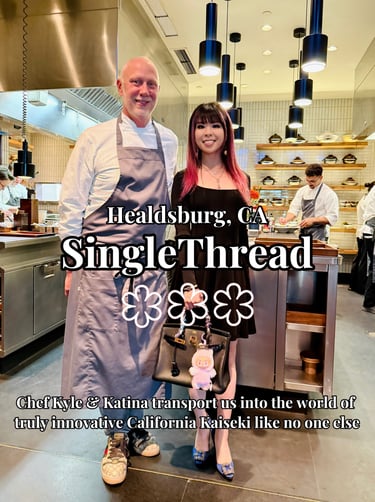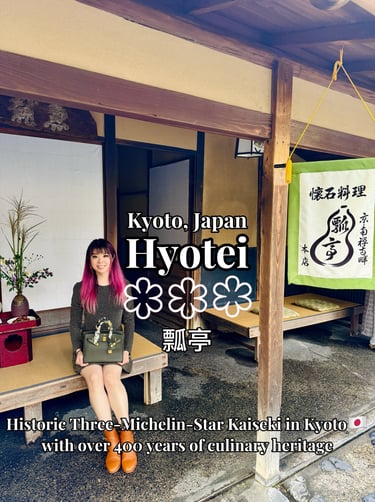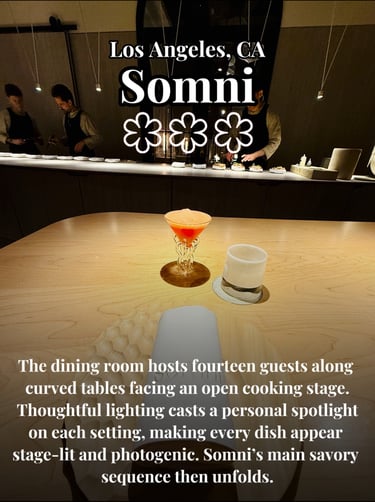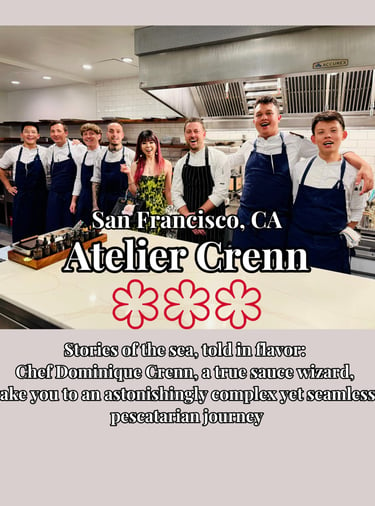Newly Michelin-Starred Lilo: Exploring Chef Bost’s Evolving Tasting Menu
MICHELINFEATURED
Carlsbad’s newly Michelin-starred Lilo—awarded its first star just ten weeks after opening in April 2025—has rapidly become one of California’s most talked-about fine-dining destinations. Led by restaurateur John Resnick and Executive Chef Eric Bost, the team behind the Michelin-starred Jeune et Jolie, Lilo has quickly drawn the attention of Michelin-focused diners across the state. This feature offers an immersive, course-by-course look at Lilo’s tasting menu through a distinctly Japanese lens, providing detailed insights into ikejime fish, the restaurant’s use of traditional katsuobushi techniques, and how each dish resonates on a Japanese palate. At its core, the narrative highlights the ingredients, flavor structure, and cultural nuance that shape the menu—while also extending to the dining room design, the open-kitchen performance, and the people-oriented service that define the experience. Together, these elements form a comprehensive portrait of a young Michelin-starred Carlsbad restaurant whose craft, clarity, and energy are already shaping its rapid rise.
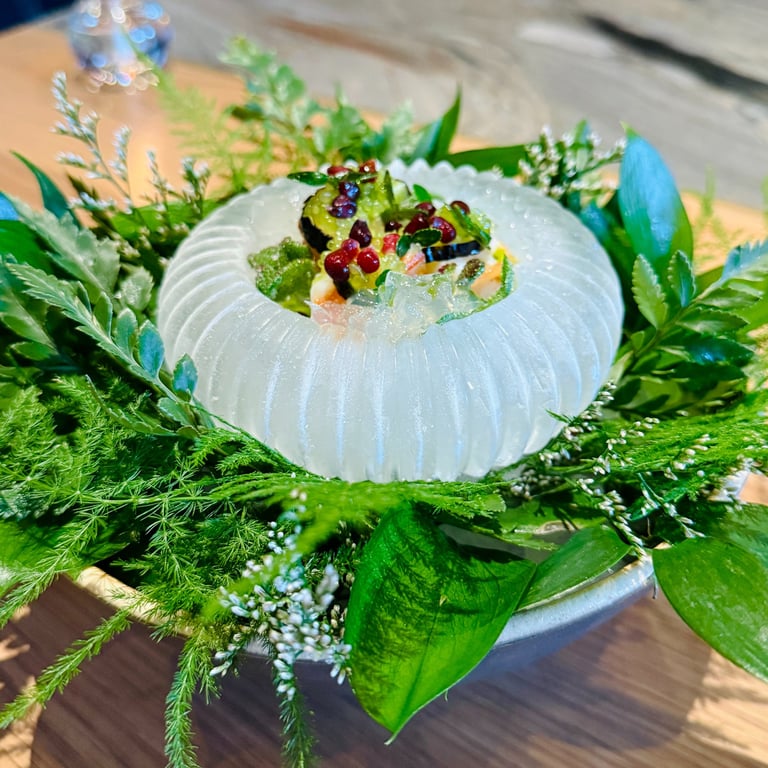

Lilo's "Spiny Lobster" in an ice bowl (Photo by Junko Y.)
Lilo, the new Oceanside gem, has quickly become the talk of California’s culinary circles. In a state that is home to the nation’s highest number of three-Michelin-star restaurants, Lilo has emerged as one to watch. Just ten weeks after opening its doors in April 2025, the restaurant earned its first Michelin star—a rare and remarkable achievement. The anticipation was inevitable: this is the latest creation from renowned restaurateur John Resnick and Executive Chef Eric Bost, the acclaimed duo behind the Michelin-starred Jeune et Jolie. This October, Chef Bost’s international recognition grew further when he was honored at The Best Chef Awards. California’s Michelin regulars are watching closely, many wondering whether Lilo’s trajectory could soon lead to a second star. Here is how the experience unfolds.
Lilo redefines the notion of arrival. At many Michelin-starred restaurants, guests catch a glimpse of the refined world awaiting them even before stepping inside. Lilo, however, conceals its world behind a sculptural façade of tall, undulating wooden walls. From the street, nothing is visible—no glimpse of the dining room, no clue of what lies within. Instead of a door, guests enter through the wooden walls themselves, as though slipping into a secluded modern lodge set in an imagined wilderness. The absence of a visible entrance transforms a simple act—stepping inside—into a portal between the everyday and the extraordinary.


Lilo's Entrance (Photo by Junko Y.)
The Welcome Sequence
Once within the warm wooden enclosure, the tone shifts from intrigue to grace. A friendly server greeted me and led me to an outdoor table in “the garden”—a serene space that precedes the dining room. The evening began with a bright, refreshing welcome drink of tomato and tarragon, an elegant prelude to the opening sequence of canapés that would introduce the restaurant’s rhythm and creativity.
The Dayboat Scallop, presented on rugged stones with foraged greens, immediately resonated with me—a diner from Tokyo—as a refined nod to Japanese aesthetics. Paired with red shiso, citrus fern, marigold, and fermented raspberry jam, the scallop delivered a delicate balance of sweet marine richness, bright citrus, and a whisper of vinegar. The ingredient itself—sourced from Day Boat Fresh in Maine, founded by sustainable-seafood pioneer Sue Buxton, a respected purveyor devoted to responsibly harvested, high-quality seafood since the 1990s—embodied Lilo’s ethos of integrity and reverence for authentic sourcing.
Alongside it was the Sweet Corn Croustade—a crisp cup filled with corn pudding, lime zest, green blueberries, lemon balm, basil, and spring blossoms. The kitchen juices fresh corn daily, and the purity of the resulting juice shines vividly: sweet, layered with verdant herbal tones and the lively freshness of basil. For my Japanese palate, the sweetness was slightly assertive for an opening bite, yet undeniably engaging—an audacious gesture that heightened my curiosity for what would follow.
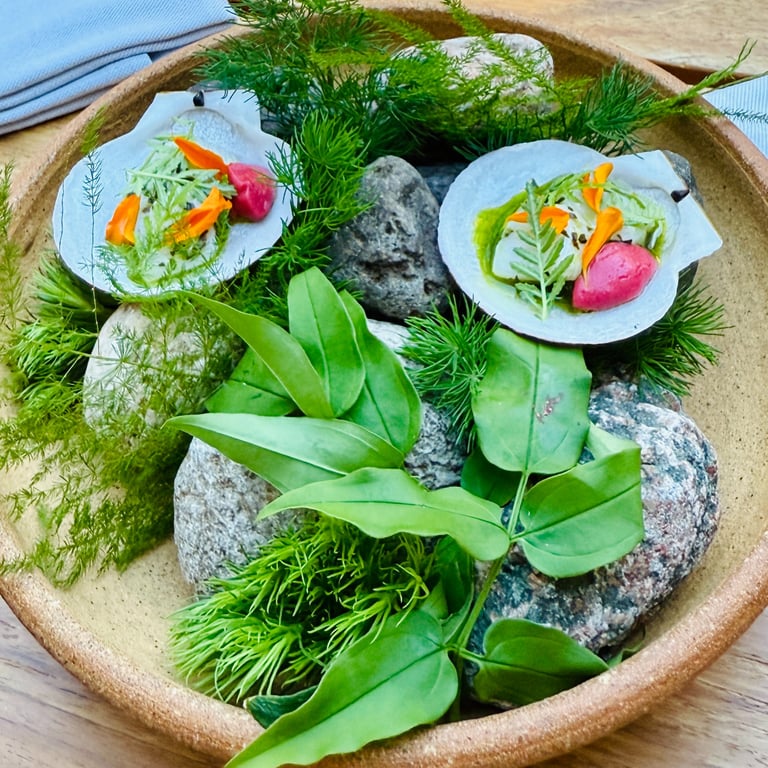

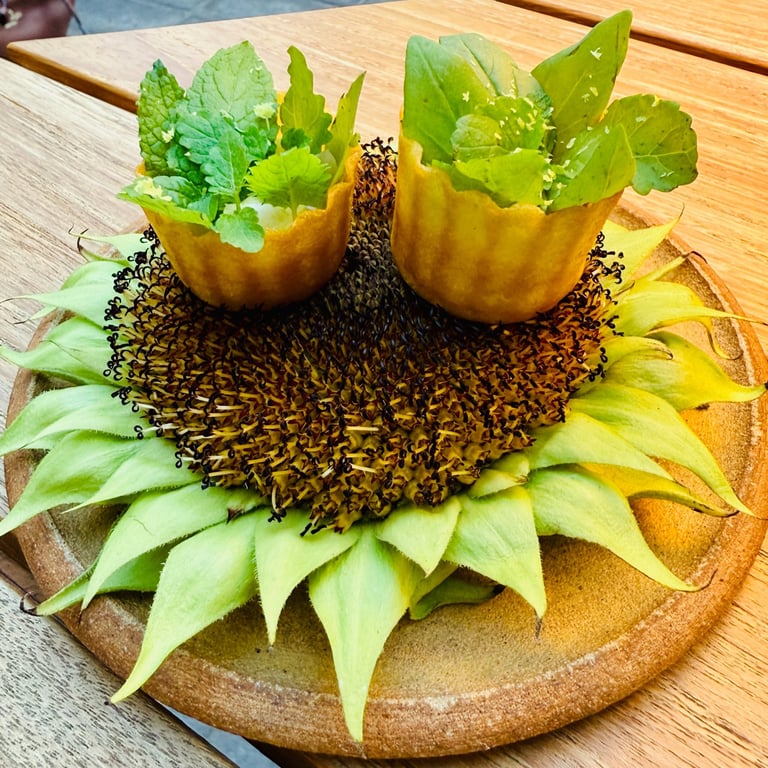

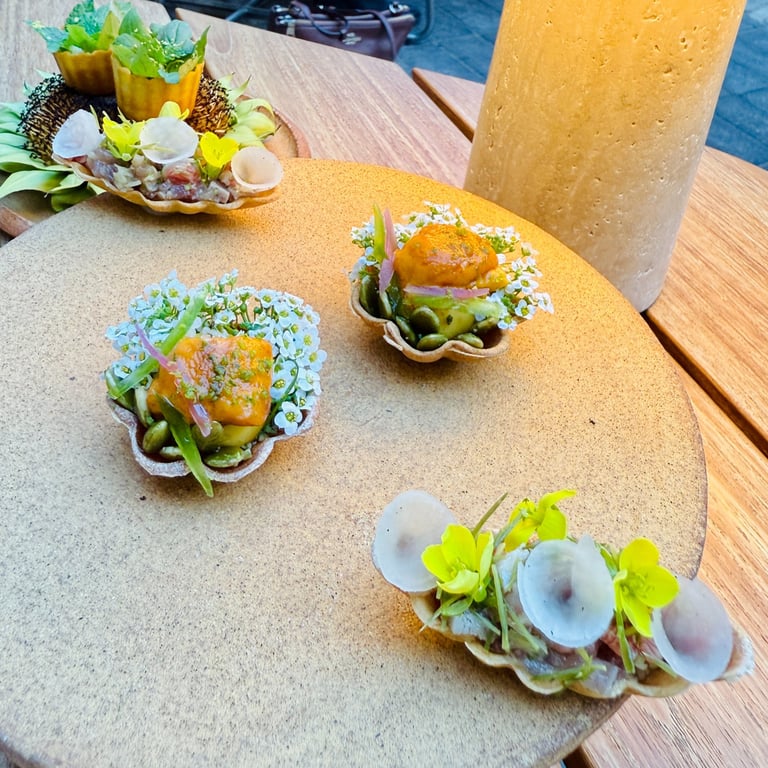

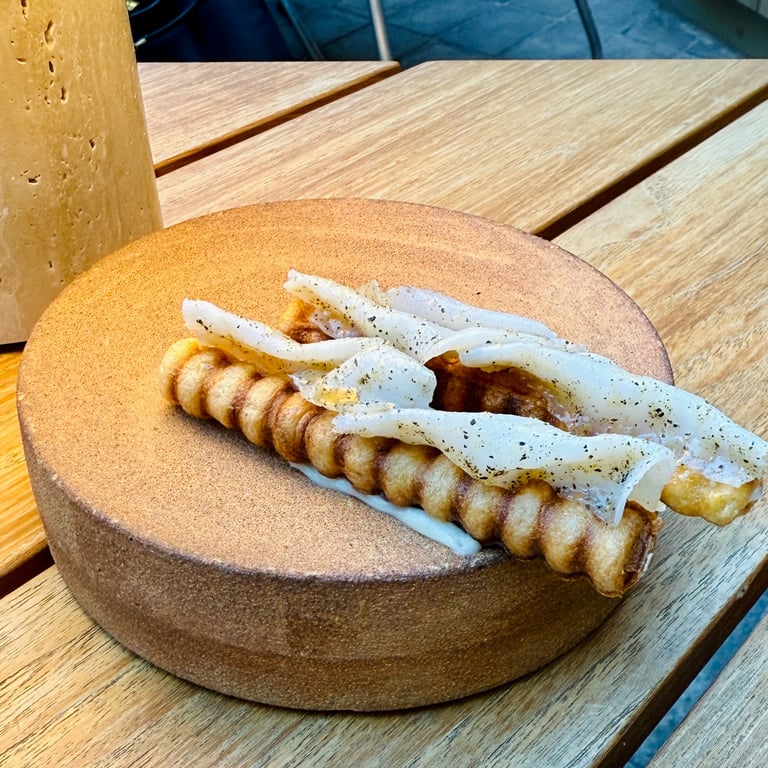

Dayboat Scallop (Photo by Junko Y.)
Sweet Corn Croustade (Photo by Junko Y.)
Big Eye Tuna and Wagyu Beef Tartare and Santa Barbara Sea Urchin (Photo by Junko Y.)
Gougère (Photo by Junko Y.)
The Big Eye Tuna and Wagyu Beef Tartare, crafted from A5 Wagyu and yellowtail tuna, contributed depth and playfulness. Seasoned with ginger ponzu and fresh spruce, with subtle hints of spice and smokiness, it offered layered complexity, while a crisp black radish garnish provided an unexpected textural counterpoint.
Completing the opening quartet was the visually delightful Santa Barbara Sea Urchin, paired with butternut squash, pumpkin seeds, koji, pickled myoga, jalapeño, and white alyssum blossoms. The uni’s sweetness—free of any alum trace—melded seamlessly with the aromatic interplay of myoga and jalapeño. Having grown up with myoga in Japan and discovering jalapeño in California, I felt this combination formed a dialogue between two culinary worlds: thoughtful, personal, and quietly original. With so many flavors contained in a single bite, it became my favorite of the opening sequence.
Just as I believed the prologue had concluded, a fifth bite arrived: a Gougère enriched with Ibérico lardo, Comté Mornay, and barrel-aged maple syrup. The luxurious fattiness and sweet-savory interplay were bold choices for an opening chapter—a subtle yet distinct statement from Lilo, signaling the creativity and confidence to come.
These early courses made clear that Lilo does not simply follow convention. The interplay of sweetness, herbal aromatics, and richness—infused with global influences and rooted in local integrity—revealed a distinctive creative voice. Lilo’s opening sequence alone demonstrated a rare balance of curiosity and technical mastery, leaving me eager to see how they would sustain such range and harmony through the main progression.
The Setting of the Dining Room
Entering the main dining room reveals a stage-like setting, where guests encircle a central thrust stage that naturally draws every gaze toward the chefs at work.
Downstage, they compose canapés and the opening course with quiet precision, while the stage extends upstage to accommodate the preparation of the main savory dishes—from lobster to wagyu. The setting evokes an intimate, culinary rendition of a chamber performance, where every gesture and detail of the artistry can be observed up close.
The design immerses guests not merely as diners, but as an attentive audience witnessing a live act of craft. One can sense the professional energy of the room—the hiss of pans, the focused intensity behind each gesture, the brief yet purposeful exchanges between chefs.
Every element—from the fierce fire to the metallic Michelin statue overseeing the tickets—draws guests closer to the craft itself, creating a connection that feels both dynamic and intimate.
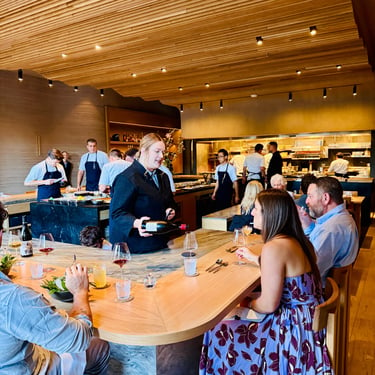

Lilo's Dining Room (Photo by Junko Y.)
The Main Savory Sequence
The sequence began with a graceful presentation: a crystal ice bowl resting atop a bed of vivid green, revealing the evening’s first dish—Spiny Lobster from the coast of San Diego.
Its inherent sweetness was preserved through gentle steaming and restrained seasoning of lemon oil, juice, and zest, allowing the pristine oceanic umami to shine.
Surrounding garnishes added layers of playfulness and contrast: charred Persian cucumber offered smoky earthiness; liquid-nitrogen-frozen blackberries imparted a fleeting chill; finger-lime pearls added subtle citrus pops; and kinome leaves (young sansho leaves) contributed a delicate peppery lift.
Local ice plant from nearby San Marcos underscored Lilo’s connection to regional producers. A final touch—a translucent tomatillo gelée—offered clarity, supple texture, and bright, plum-like tartness.
This opening dish was beautifully conceived—light yet full of textural intrigue, temperature play, and visual impact. It prepared guests with freshness and creativity.



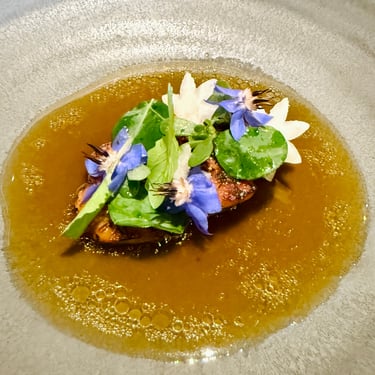
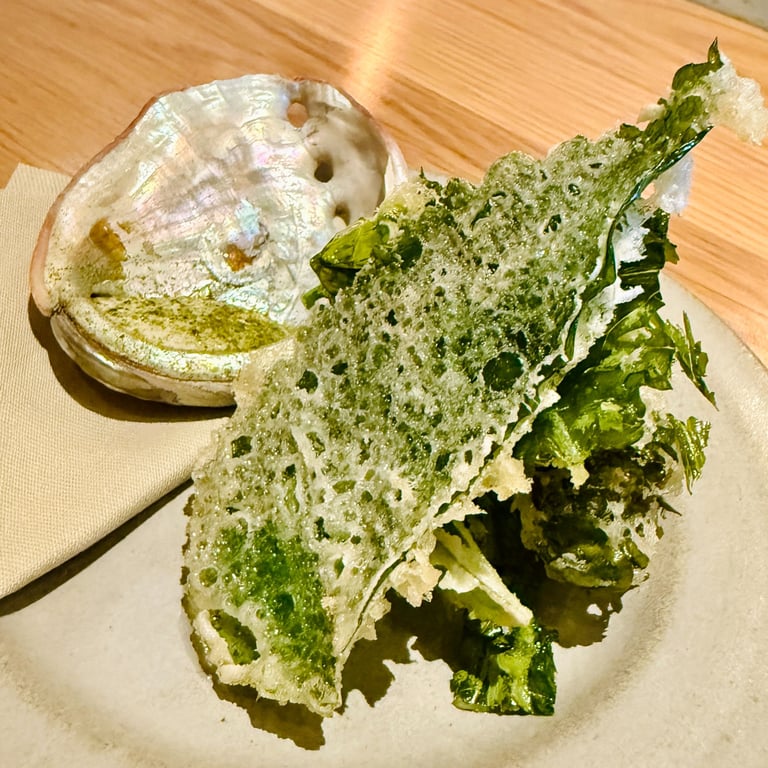

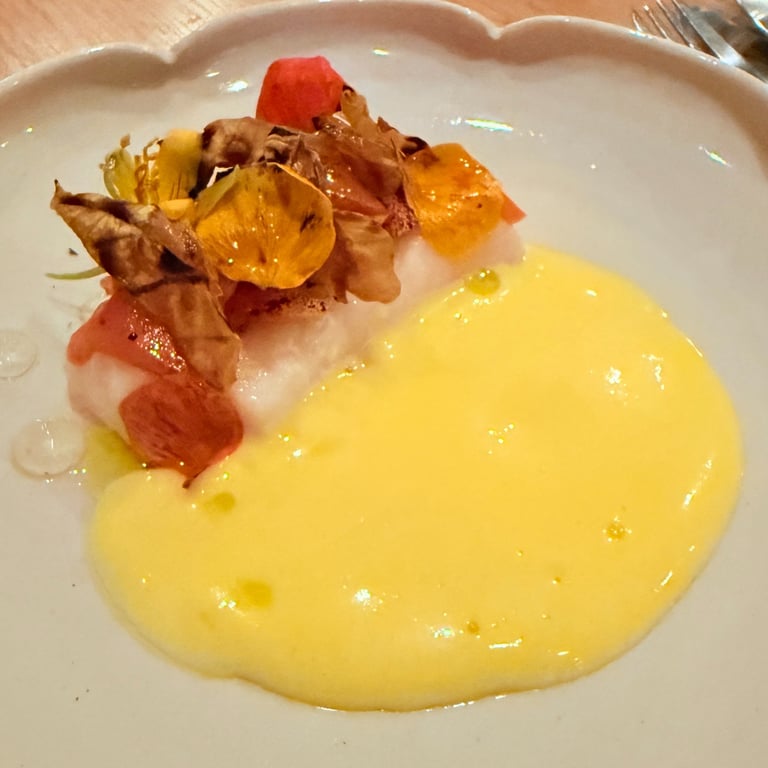

Spiny Lobster (Photo by Junko Y.)
Abalone (Photo by Junko Y.)
Abalone—Oyster Emulsion and Tempura (Photo by Junko Y.)
Ikejime Black Cod (Photo by Junko Y.)
The next dish, Abalone, arrived with an elegant waft of smoke that immediately filled the air. A composition of purple flowers, white turnips, and tender greens crowned the abalone, which rested in a translucent, amber-hued broth— visually vibrant and deeply inviting.
The abalone, grilled to tender perfection and lacquered with a glaze of fermented peppers, guanciale, and anchovy before being finished over the embers, offered a refined interplay of smokiness, oceanic sweetness, and a distinctive gentle chew. The accompanying consommé of roasted chicken and bone marrow introduced a naturally caramelized sweetness, adding depth and subtle richness to the dish’s umami register. As the server noted with a smile, “A little chicken got lost in the sea right here.” Yet, the poultry did not feel lost; it fused harmoniously with the oceanic aroma.
Presented alongside was an abalone shell filled with a Shigoku oyster emulsion. These Pacific oysters—cultivated in Washington by Taylor Shellfish Company since 2009—brought silky marine richness. A sesame leaf and yu choy tempura, dusted with allium powder and served for dipping into the emulsion, offered a crisp, vegetal contrast.
This course emerged as one of the evening’s most thoughtfully composed creations. As a devotee of chicken consommé, I found Chef Bost’s version notably focused—its clarity revealing deliberate craft and restraint. The consommé, deceptively simple and transparent, is among the most unforgiving of preparations, yet he executed it with precision and depth, creating a refined foundation for the abalone’s delicate flavor. While the pairing of abalone and poultry broth is rooted in tradition, achieving harmony between such distinct elements demands control and confidence—and here, every note felt beautifully tuned.
The only element that seemed slightly discordant was the tempura leaves: their pronounced saltiness, while flavorful, momentarily disrupted the consommé’s elegant, restrained balance. Served side by side, the two components shared an oceanic sensibility but not entirely in harmony of seasoning.
Still, the composition remained one of quiet brilliance: a dialogue between sea and land, between delicacy and complexity. With two plates—abalone in consommé and the luxurious oyster emulsion with tempura greens—Chef Bost revealed a layered, multidimensional approach that distilled remarkable thought and technique into a single course.
Yet, to my palate, the pairing felt slightly misaligned. The natural sweetness of the ikejime black cod and the elegant tartness of the sabayon didn’t entirely harmonize; the sauce, though thoughtfully constructed, faintly overshadowed the fish’s purity. Perhaps it was a matter of cultural sensibility—my preference for lighter, more restrained seasoning—but I still appreciated the intention behind the pairing. The Sabayon of Pineau des Charentes was graceful and well crafted, though its richness, to my palate, somewhat dominated the cod’s delicate sweetness.
Next came Ikejime Black Cod. Ikejime refers to the meticulous Japanese method of dispatching and bleeding fish immediately after catching, preserving its freshness and preventing the development of unwanted odors. Ike means “live,” and jime (or shime) means “to close.” By contrast, most supermarket fish are nojime—not properly drained—resulting in a noticeably pungent odor. Properly treated ikejime fish, however, should carry only the clean scent of the sea.
The cod, aged for three to four days, was lightly steamed to retain its soft texture and natural sweetness, then seasoned with lemongrass. It was garnished with “roses three ways”—grilled petals, lightly preserved petals, and a rose petal fluid gel—alongside slices of nectarine dusted with umeboshi-shiso powder. The chef completed the dish with a Sabayon of Pineau des Charentes—a French fortified wine similar to cognac—and a drizzle of yuzu oil for a bright lift of citrus.
As the chef detailed the dish’s intricate layers, anticipation grew. Coming from Japan, I hold particularly high standards for fish preparation—it is rare to encounter one abroad that captures the same delicacy and precision. The black cod itself was exquisite—beautifully cooked, with an elegant sweetness and supple texture—while the floral and fruity garnishes enhanced its fragrance. The interplay of umeboshi-shiso and yuzu achieved a quietly refined balance. The sabayon was luscious and layered, carrying both brightness and depth.
Pastry Chef Madeline Biehl presented one of the evening’s most memorable and indulgent dishes: N25 Kaluga Caviar. At its base was an orgeat ice cream—made from candied almonds and orange blossom water—topped with a glistening layer of N25 Kaluga Hybrid Caviar.
Adding a distinctive smoky umami dimension was smoked celery root “bushi,” inspired by Japan’s traditional katsuobushi (smoke-dried, fermented bonito). The team created their own version by marinating celery root in tamari and brown sugar, smoking it over applewood for two days, and air-drying it for depth and concentration. As a Japanese fine-dining enthusiast, I was fascinated by how they reimagined such a classic umami technique in their own way—it added a refined smokiness. A final drizzle of freshly pressed almond oil, made in-house daily, finished the composition with a soft, nutty aroma.
This ice cream course has become emblematic of Lilo. Since the restaurant’s opening, it has remained unchanged—a signature creation Chef Bost envisioned long before the concept took shape.
During my visit, I was fortunate to experience its rare seasonal enhancement: white truffles from Piedmont, Italy. Piedmont is also home to the town of Alba, whose forests supply the white truffles prized by top chefs around the world. Their fleeting aroma—"available for only five weeks each year," another chef noted—was shaved over the orgeat ice cream and caviar, infusing the dish with an intoxicating perfume.

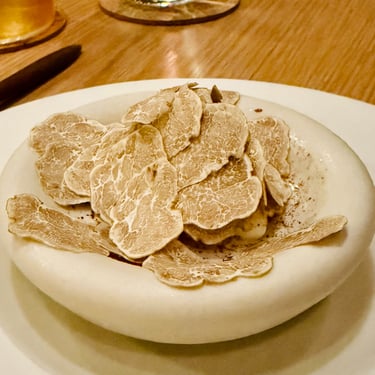

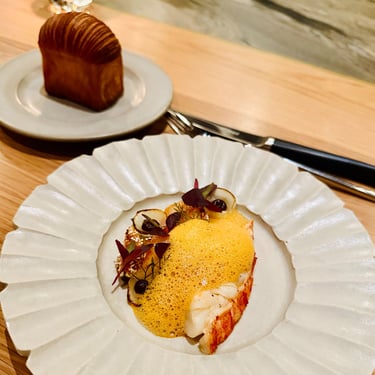
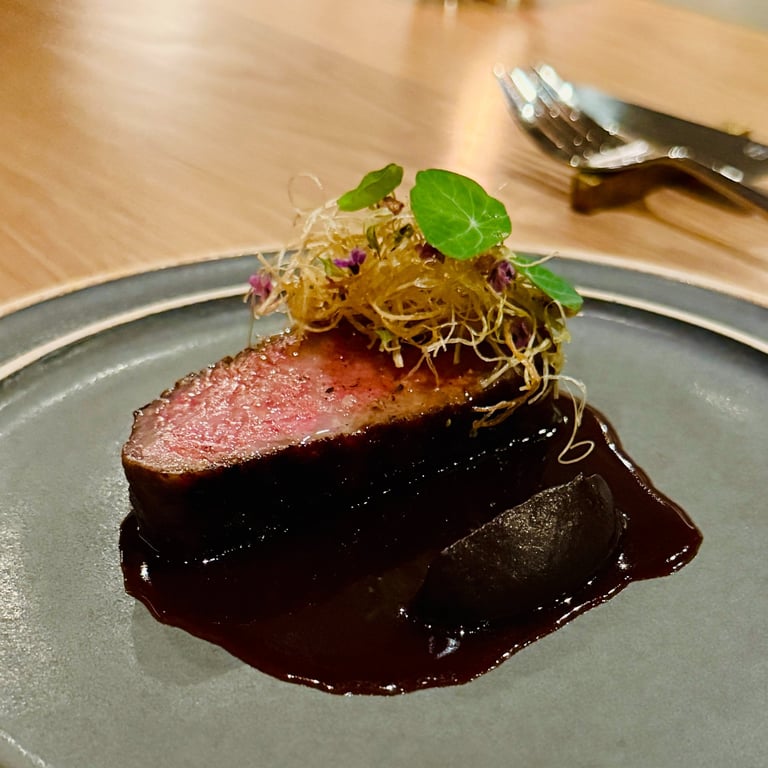

N25 Kaluga Caviar (Photo by Junko Y.)
Maine Lobster (Photo by Junko Y.)
A5 Miyazaki Wagyu (Photo by Junko Y.)
The truffle’s earthy depth met the almond’s gentle sweetness and the caviar’s oceanic salinity, while the smoky celery root bushi wove softly through it all, creating a layered harmony of contrasts—cold and warm, creamy and briny, nutty and fragrant. The first spoonful was indulgent yet composed—a fleeting moment where the perfume of truffle, the salt of the sea, and the quiet sweetness of almond seemed to suspend time, a luxurious pause before the meal’s next movement.
The Maine Lobster course arrived with a beautifully laminated brioche on the side—a golden, buttery creation that tasted like a cross between brioche and croissant. The lobster was cooked over embers, its natural sweetness meeting a subtle smoky perfume from the fire.
Two sauces completed the composition. The first was a toasted-chili blend—chipotle, Anaheim and pasilla peppers—visually fiery but restrained on the palate, adding aromatic depth rather than sharp heat. The second was an airy lobster emulsion built from roasted shells, smoked tomatoes, cognac, and aromatics, finished with lobster butter made from the extra shells to heighten and round the lobster’s umami.
On the plate, Black Mission figs, charred pearl onions (each bearing a brown, miso-like paste), bronze fennel, and butterfly sorrel added dimension: figs lending gentle sweetness, fennel a touch of anise, and sorrel a clean acidity. The lobster was perfectly cooked—succulent yet taut—while the emulsion tasted lighter than it looked, its buttery richness gently amplifying the lobster’s natural flavor.
The chili sauce expanded the dish’s aromatic range, introducing layers of smokiness that recalled, faintly, the warmth of Chinese chili pastes—an unexpected but delightful echo. Together, the components formed a dish that reflected Chef Bost’s playful creativity and his instinct for harmony: luxurious yet precise, grounded in classic technique but infused with personal nuance.
The main savory course featured a beautifully prepared Japanese A5 Miyazaki Wagyu, accompanied by a small piece of binchotan-smoked unagi (eel). On top were battera kombu—a thin white kelp traditionally used for pressed mackerel sushi—and crispy leeks with shiso blossoms, adding both texture and fragrance.
Alongside, a canal of whipped blackened shallot brought caramelized richness. As the chef explained, the shallots had been slowly preserved at 140 degrees for four months, allowing their sugars to gently caramelize until the texture turned silky and light; the team then folded in house-made koji—fermented grains that contributed subtle nuttiness, structure, and layered complexity. A jus of slow-roasted oxtail accompanied the plate, providing rounded depth.
The concept of the dish was thoughtful and inventive. Miyazaki Wagyu, renowned for its ultra-fine marbling and tenderness, can easily verge on overwhelming richness when served as a steak cut. Here, Lilo approached that intensity through the interplay of smoky unagi, briny battera kombu, and the caramelized bitterness of blackened shallot. The oxtail jus added measured savoriness, grounding the dish with slow-roasted character.
From a Japanese perspective, heavily marbled wagyu is traditionally served thinly sliced—as in sukiyaki—precisely to moderate its richness and allow the diner to savor its flavor without fatigue. While some Japanese restaurants do present it as steak, even then, the pieces are carefully portioned to maintain balance. In contrast, many fine dining restaurants in the United States serve highly marbled Miyazaki wagyu in a larger, Western-style cut; it is always intriguing to see how chefs counter its inherent ultra-richness. Chef Bost’s version revealed deliberate restraint and clear intention—his layering of smoke, bitterness, sweetness, and umami reflected a sensitivity to wagyu’s weight and allure.
Even so, to my palate, the wagyu’s richness remained slightly pronounced. The accompaniments were thoughtfully composed, though they offered a gentler counterpoint to the marbling than I anticipated; the unagi and kombu—which I was particularly looking forward to—presented themselves with a subtler imprint. This, again, may reflect a difference in cultural sensibility; Japanese preparations often favor sappari (refreshing, cleansing) elements to balance richness.
Nevertheless, the dish delivered beautiful complexity and reflected Chef Bost’s deep curiosity and cross-cultural intuition—a plate that blended French technique with Japanese awareness, executed with both care and creativity.
The Desserts
Chef Biehl began the dessert sequence with a gentle farewell to summer: Strawberry, a composition anchored in the dialogue between tomatoes and strawberries. The base combined anise hyssop and marshmallow beneath tomato jam, fresh tomatoes, and softly dehydrated strawberries, accompanied by a bright strawberry granita. The sorbet—a Nova tomato preparation with a clean, savory-leaning acidity—amplified the tomato’s depth, while the finishing touches of anise hyssop oil and strawberry consommé tied the elements together. The result was a refreshing, finely tuned transition from the richness of the wagyu, its clarity of flavor guided by the natural acidity of tomato and the cool sweetness of the fruit. The anise hyssop contributed a delicate herbal note that subtly extended the dish’s aromatic profile.
The second dessert, Blackened Banana, shifted the menu toward a bolder, deeper register. It highlighted organic Koshihikari rice cultivated in Sacramento by Wendy Tsuji, whose dedication to organic farming and sustainability brings a distinct sense of place to her grain. The plate featured toasted rice ice cream, a Medjool date cake, and an entremet filled with blackened banana jam, banana mousse, cinnamon-ginger chiffon and coated in white chocolate and puffed rice. A beautiful sheet of shiro miso caramel offered sweet saltiness and fragrant banana-peel oil added nuance. A toasted-rice doughnut served as the intended vessel for dipping, creating an interactive finish.
Learning about Tsuji’s Luna Koshihikari added a meaningful agricultural dimension to the dish. The combination of shiro miso, banana, and toasted rice offered a layered, aromatic richness and moved the menu into a bold new register, creating a purposeful contrast to the preceding course. To my palate, though, the flavors leaned slightly more assertive; a gentler touch of salt might have brought the profile closer to the balance I naturally gravitate toward. Even so, the depth of the banana, its refined sweetness, and the roasted-rice character contributed to compelling texture and complexity, making the dish feel unique and thoughtfully composed.
Together, the desserts demonstrated Chef Biehl’s thoughtful approach to flavor construction and her commitment to closing the menu with intention. In a dining landscape where pastry courses can sometimes feel secondary, her work stood out for its sense of craft, structure, and narrative continuity. Each plate reflected a careful balance of technique and creativity, contributing a resonant final chapter to the tasting menu.


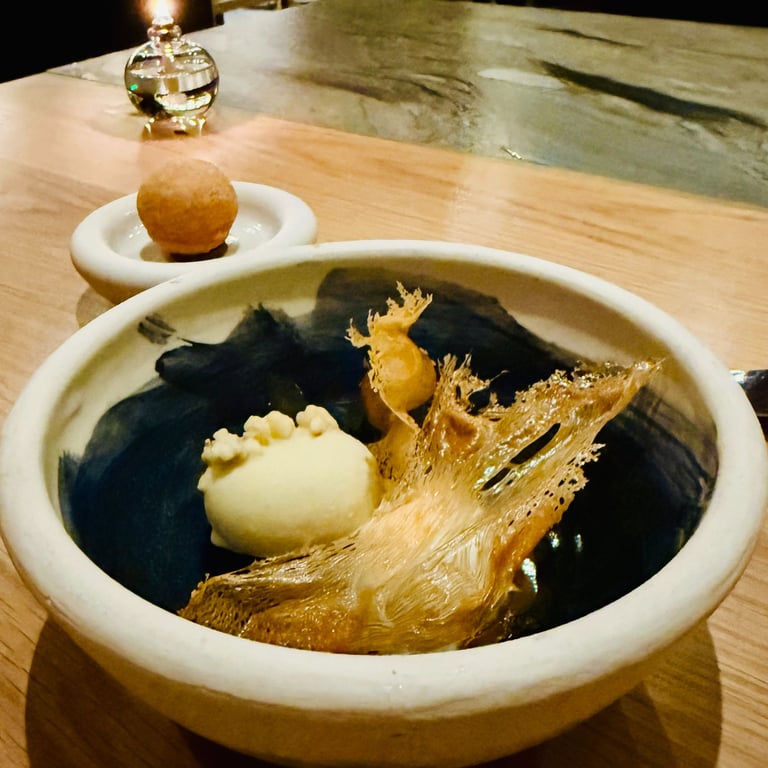

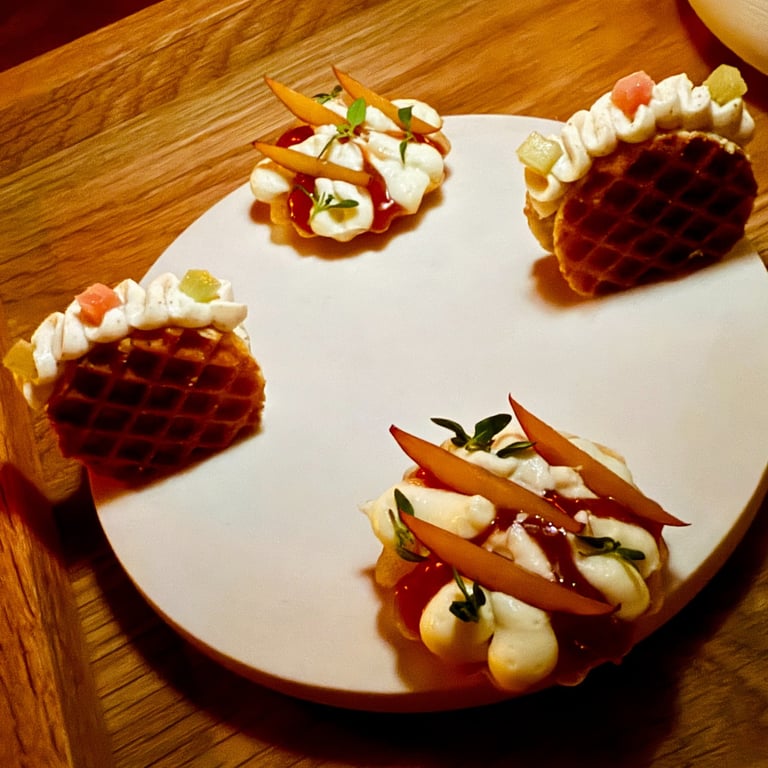

Strawberry (Photo by Junko Y.)
Blackened Banana (Photo by Junko Y.)
Stroopwaffle and Plum Tartelette (Photo by Junko Y.)
Brown Butter Financier (Photo by Junko Y.)
I was then escorted back to “the garden” for the final dessert bites. All three were delicately composed, each with its own intricate details and visually engaging presentation. The first, Stroopwaffle filled with rhubarb gelée and toasted milk crémeux, offered a light, crisp bite with a restrained sweetness that felt especially satisfying at this stage of the menu.
The second, Plum Tartelette, featured whipped lemon-thyme ganache and plum jam, enriched with Hawaiian brown butter. The plum brought a welcome acidity and subtle crunchy texture, creating a balanced counterpoint to the creaminess and sweetness of the ganache while complementing the freshness of lemon-thyme.
The final bite, Brown Butter Financier, was an almond financier topped with a generous layer of crèmeux, matcha ganache, and toasted coconut clusters. Its soft texture and gentle, warm flavors made it an ideal conclusion—calming, comforting, and fitting for a quiet moment in “the garden” at the end of the tasting menu.
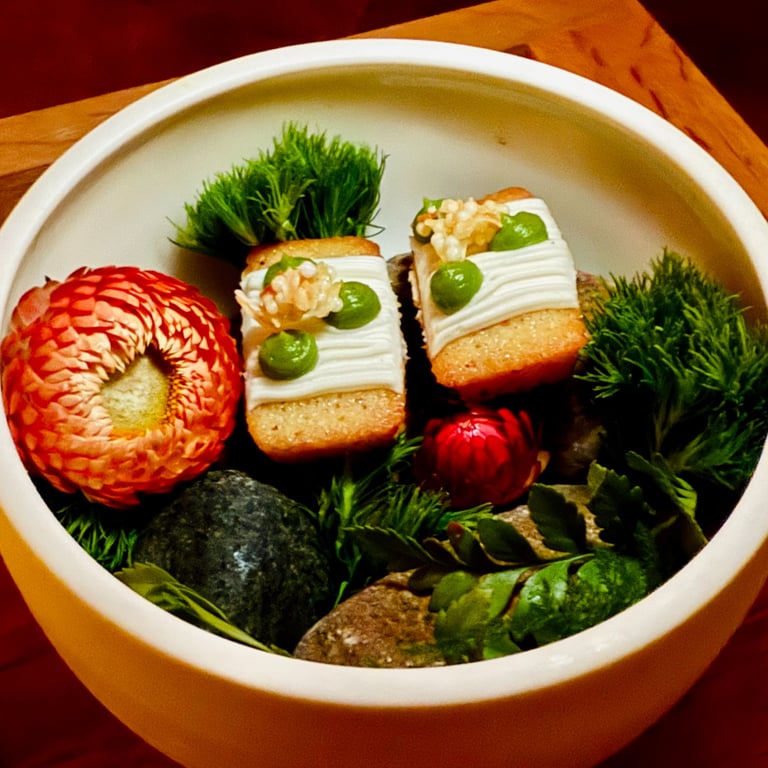

The Service
The service at Lilo was equally remarkable. From the very first moment, the server greeted me by name, despite it being my first visit, immediately conveying a sense of care and attention. My Japanese name is often mispronounced, yet the server articulated it carefully, with a presence that made the greeting feel both respectful and meaningful. Thoughtful details extended to the menu cover, which evoked the elegance of a Japanese furoshiki, and the inclusion of descriptions for the amuse-bouches—a small touch that many fine dining establishments traditionally omit. The curated ambiance, including Jamiroquai playing softly in the background, further enhanced the intimate experience.
The open kitchen format offered a particularly memorable insight into Lilo’s service philosophy. Guests can watch the chefs craft each dish, then have the same chef present it at the table, explaining the ingredients and concept. At some restaurants, chefs bringing dishes to the table often speak with the rapid, time-pressured rhythm of the kitchen, which can leave guests feeling rushed or uncertain about the details. At Lilo, however, every chef struck a remarkable balance—shifting naturally from intense focus on their craft to warm and engaging explanations. Observing this brought a fresh appreciation, as they managed to combine technical mastery with genuine hospitality. Creating such detailed culinary art under time pressure is one challenge; seamlessly shifting into “presenter mode” without appearing rushed or disengaged is another. At Lilo, every chef and staff member handled both with remarkable poise.
This combination of technical mastery and interpersonal skill is clearly cultivated with intention. Many chefs of my chef father’s generation in Japan were kamoku—silent and entirely focused on craft, often appearing intimidating to guests. The chefs at Lilo, in contrast, are both highly skilled and genuinely welcoming. Their warmth, patience with questions, and professional friendliness reflect the people-oriented culture of California, making the dining experience not only impressive but also deeply inviting. Experiencing it left me eager to return.
The Final Thought
As many Michelin-dining enthusiasts had suggested, this seven-month-old restaurant already reveals an impressive command of technique and precision. Chef Bost’s deep knowledge, openness to global ingredients, and willingness to experiment shine clearly; Chef de Cuisine Dušan Todić and the team’s curiosity, passion, and originality resonate in every course. Through the open kitchen and the conversations with the chefs and staff, I felt a strong sense of momentum—an eagerness to grow, to refine, and to push further. The atmosphere is unmistakably young, energetic, and refreshing.
The desserts also stood out as a notable strength. Chef Biehl’s creativity, enthusiasm for exploring diverse ingredients, and ability to maintain a through-line from the savory courses created a thoughtful continuity across the menu.
When considering overall consistency of taste, a few elements still felt like they were searching for their ideal dynamic range. Some flavors arrived fortissimo when a measured mezzo-forte might have revealed more nuance; others were rendered in a gentle pianissimo that became difficult to perceive when paired with more assertive notes. Yet, given the team’s evident energy and openness to evolution, it seems only a matter of time before Lilo shapes these dynamics into a fully integrated score.
Witnessing the early chapters of Chef Bost’s rapidly rising restaurant is genuinely exciting. Lilo has already established a compelling creative voice, and I look forward to following its progression. This newly Michelin-starred Carlsbad restaurant is one to keep a close eye on.
Visited: October 16, 2025
